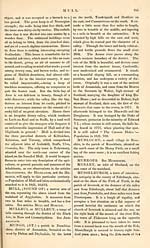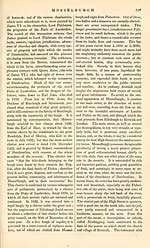Gazetteer of Scotland > Volume 2
(312) Page 796
Download files
Complete book:
Individual page:
Thumbnail gallery: Grid view | List view

796
MUSSELBURGH.
Northumbrian Saxons, in whose time it was
a seat of population. Throughout its early
history the town was intimately associated with
the fortunes of the parish of Inveresk, of which
it is the capital. It is found that at the dawn
of record, there existed two manors of the name
of Inveresk, to wit, Great- Inveresk and Lit-
tle-Inveresk. The manor of Little- Inveresk
was gifted by Malcolm Canmore and Mar-
garet his queen, to the monks of Dunfermline,
(see Dunfermline) ; and the grant was con-
firmed by a charter of David I. ; who added a
donation of Great- Inveresk, with the mill, the
fishing, and the church of Inveresk, its tithes,
and other pertinents. These grants were con-
firmed by David's successors, and by a bull of
Gregory IX., in 1236. The gift of Great-
Inveresk included the burgh and port of
Musselburgh. In the year 1201, the Magnates
Scolice swore fealty to Alexander II., the in-
fant son of William the Lion, at Muschelburg.
Alexander afterwards established a free warren,
within the manors of Inveresk and Mussel-
burgh, in favour also of the monks of Dun-
fermline. From the grants of David I. the
monks enjoyed a baronial jurisdiction over all
those lands ; and they afterwards obtained a
grant extending their powers to a regality. In-
veresk church seems to have been served by
vicars from Dunfermline, who were sometimes
styled " vicars of Muscilburg," and they ap-
pear as witnesses to many charters, among
men of consequence. In Bagimont's roll, as
it stood under James V., the vicarage of Mus-
cilburg was taxed at L.5, 6s. 8d. Early in
the thirteenth century, a dispute arose between
the monks and the vicar, which was settled by
the diocesan bishop, who directed that the
vicar should enjoy the small tithes, and the
offerings at the altars of Muscilburg ; excepting
the fish of every sort, and the tithes of the
mills, belonging to the monks, for which the
vicar was directed to pay yearly ten merks.
In the church of Inveresk, which was dedicat-
ed to St. Michael, there were several altars,
with their chaplains, who were endowed with
small livings for performing at them their ap-
propriate worship. Accordingly, we find that
in 1475, Sir Simon Preston of Craigmiller,
gave an annual rent of ten merks out of the
lands of Cameron to a chaplain, to do service
at a particular altar in Musselburgh church ;
and that James III. confirmed the grant. In
the parish there were various chapels, subordin-
ate to the mother church. Of those none were
so celebrated as that of Our Lady of Loretto,
at the east end of Musselburgh, which had the
cell of a hermit adjoining. To this chapel, in
a superstitious age, many pilgrimages were per-
formed, in the vain expectation of seeing mira-
cles performed, by the curing of diseases, or for
the purpose of beseeching the kindly exertions
of the patroness of the sanctuary. To it, in
the year 1530, James V. performed a pilgrim-
age from Stirling on foot, before proceeding
on his voyage to France in search of a wife.
What began in the depth of devotional piety,
however misdirected, ultimately degenerated into
absolute vice. It is observable from the satires
of Sir David Lindsay, which are well known to
have been pointed with the severest ridicule of
the ancient faith, that the chapel of Loretto
was resorted to by all classes of the communi-
ty, for purposes partly religious, but in many
cases for the indulgence of licentious passions.
During the Earl of Hertford's ravages, in 1544,
he destroyed the chapel of Loretto, with a part
of the town. It was, however, soon repaired,
but the Reformation in a few years overtook it,
and it was finally abolished and deserted. The
materials of the ruined chapel are said to have
been the first belonging to any sacred edifice
which were, after the Reformation, applied to
a secular purpose ; having, in 1590, been made
use of in the building of the tolbooth of Mus-
selburgh ; for which piece of sacrilege, it is said,
the inhabitants of the town were annually ex-
communicated at Rome till the end of the last
century. The site of the chapel and hermi-
tage is now occupied as a flourishing academi-
cal seminary, still under the name of Loretto,
and is surrounded by a delightful garden and
pleasure-ground. All that remains of the an-
cient structure is a cell above ground covered
with shrubbery, and used as a common cellar ;
in lowering the floor of which, in the year
1831, a number of human skulls were dug out.
Above the doorway is an antique carved stone,
but from a date upon it, we would suppose it to
be of an age subsequent to the Reformation.
In the town of Musselburgh there were two
other chapels, though of less note. The valu-
able territory and privileges once belonging
to the monks of Dunfermline, their vicars and
chaplains, became in time the property of a
lay nobleman, as was usual with the wealth cf
the church. The lordship and regality of
Musselburgh, with the patronage of the church
MUSSELBURGH.
Northumbrian Saxons, in whose time it was
a seat of population. Throughout its early
history the town was intimately associated with
the fortunes of the parish of Inveresk, of which
it is the capital. It is found that at the dawn
of record, there existed two manors of the name
of Inveresk, to wit, Great- Inveresk and Lit-
tle-Inveresk. The manor of Little- Inveresk
was gifted by Malcolm Canmore and Mar-
garet his queen, to the monks of Dunfermline,
(see Dunfermline) ; and the grant was con-
firmed by a charter of David I. ; who added a
donation of Great- Inveresk, with the mill, the
fishing, and the church of Inveresk, its tithes,
and other pertinents. These grants were con-
firmed by David's successors, and by a bull of
Gregory IX., in 1236. The gift of Great-
Inveresk included the burgh and port of
Musselburgh. In the year 1201, the Magnates
Scolice swore fealty to Alexander II., the in-
fant son of William the Lion, at Muschelburg.
Alexander afterwards established a free warren,
within the manors of Inveresk and Mussel-
burgh, in favour also of the monks of Dun-
fermline. From the grants of David I. the
monks enjoyed a baronial jurisdiction over all
those lands ; and they afterwards obtained a
grant extending their powers to a regality. In-
veresk church seems to have been served by
vicars from Dunfermline, who were sometimes
styled " vicars of Muscilburg," and they ap-
pear as witnesses to many charters, among
men of consequence. In Bagimont's roll, as
it stood under James V., the vicarage of Mus-
cilburg was taxed at L.5, 6s. 8d. Early in
the thirteenth century, a dispute arose between
the monks and the vicar, which was settled by
the diocesan bishop, who directed that the
vicar should enjoy the small tithes, and the
offerings at the altars of Muscilburg ; excepting
the fish of every sort, and the tithes of the
mills, belonging to the monks, for which the
vicar was directed to pay yearly ten merks.
In the church of Inveresk, which was dedicat-
ed to St. Michael, there were several altars,
with their chaplains, who were endowed with
small livings for performing at them their ap-
propriate worship. Accordingly, we find that
in 1475, Sir Simon Preston of Craigmiller,
gave an annual rent of ten merks out of the
lands of Cameron to a chaplain, to do service
at a particular altar in Musselburgh church ;
and that James III. confirmed the grant. In
the parish there were various chapels, subordin-
ate to the mother church. Of those none were
so celebrated as that of Our Lady of Loretto,
at the east end of Musselburgh, which had the
cell of a hermit adjoining. To this chapel, in
a superstitious age, many pilgrimages were per-
formed, in the vain expectation of seeing mira-
cles performed, by the curing of diseases, or for
the purpose of beseeching the kindly exertions
of the patroness of the sanctuary. To it, in
the year 1530, James V. performed a pilgrim-
age from Stirling on foot, before proceeding
on his voyage to France in search of a wife.
What began in the depth of devotional piety,
however misdirected, ultimately degenerated into
absolute vice. It is observable from the satires
of Sir David Lindsay, which are well known to
have been pointed with the severest ridicule of
the ancient faith, that the chapel of Loretto
was resorted to by all classes of the communi-
ty, for purposes partly religious, but in many
cases for the indulgence of licentious passions.
During the Earl of Hertford's ravages, in 1544,
he destroyed the chapel of Loretto, with a part
of the town. It was, however, soon repaired,
but the Reformation in a few years overtook it,
and it was finally abolished and deserted. The
materials of the ruined chapel are said to have
been the first belonging to any sacred edifice
which were, after the Reformation, applied to
a secular purpose ; having, in 1590, been made
use of in the building of the tolbooth of Mus-
selburgh ; for which piece of sacrilege, it is said,
the inhabitants of the town were annually ex-
communicated at Rome till the end of the last
century. The site of the chapel and hermi-
tage is now occupied as a flourishing academi-
cal seminary, still under the name of Loretto,
and is surrounded by a delightful garden and
pleasure-ground. All that remains of the an-
cient structure is a cell above ground covered
with shrubbery, and used as a common cellar ;
in lowering the floor of which, in the year
1831, a number of human skulls were dug out.
Above the doorway is an antique carved stone,
but from a date upon it, we would suppose it to
be of an age subsequent to the Reformation.
In the town of Musselburgh there were two
other chapels, though of less note. The valu-
able territory and privileges once belonging
to the monks of Dunfermline, their vicars and
chaplains, became in time the property of a
lay nobleman, as was usual with the wealth cf
the church. The lordship and regality of
Musselburgh, with the patronage of the church
Set display mode to: Large image | Transcription
Images and transcriptions on this page, including medium image downloads, may be used under the Creative Commons Attribution 4.0 International Licence unless otherwise stated. ![]()
| Gazetteers of Scotland, 1803-1901 > Gazetteer of Scotland > Volume 2 > (312) Page 796 |
|---|
| Permanent URL | https://digital.nls.uk/97434566 |
|---|
| Description | Volume II: Glenbanchor to Zetland. |
|---|---|
| Attribution and copyright: |
|
| Description | By Robert Chambers and William Chambers. Glasgow: Blackie & Son, 1838. 2 volumes. |
|---|---|
| Shelfmark | NF.1461.g.7 |
| Additional NLS resources: | |

